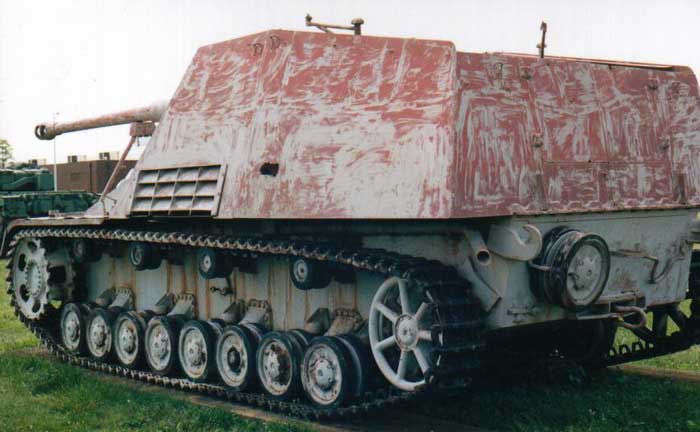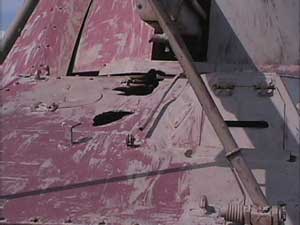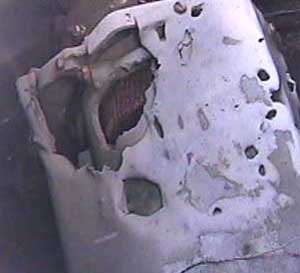|
|
|
RHINOCEROS
RHINOCEROS

|
Originally known as Hornisse (Hornet), this armoured fighting vehicle first saw service in 1943. Between February 1943 and March 1945, 473 of these vehicles were built during which time it's name was changed to the more aggressive Nashorn (Rhinoceros). |

|

|
Thinly armoured and with an open fighting compartment, the Rhinoceros was vulnerable to infantry and low caliber canon fire. This hit in the front appears to line up with the damage at the lower left side of the canon area. With the engine and transmission in the front were the driver sits, in the picture below, this damage is visible through the hole in the front.
Another drawback was in the chassis design, a combination of a Pzkpfw III and IV. Roughly the
size |

|

|
|
Vulnerable as the Rhinoceros was, as a fighter, it was extremely dangerous. Equipped with the best armour piercing gun of any country during World War 2, its 88mm Pak 43 /1L/71 gun with 3340 ft per second muzzle velocity could destroy anything the allies put on the battlefield. Taking advantage of their long range killing ability, most of that could be done at safe distances. These vehicles were so effective that they were formed into independent tank destroying units accompanied with infantry. Its 88mm gun was capable of firing an HE (high-explosive) round that had a good fragmentation effect. This is something the allies attest to in their documented findings of the guns potential. In my opinion, the profile of the Rhinoceros with its impressive 88mm gun hanging out over and past the front of the vehicle, leaves no doubt what this weapon did to enemy armor. |

|

|
|
Specifications of the | |
WEIGHT | 23.6 Tons |
|---|---|
CREW | 4 |
ARMAMENT | One 88-mm PaK 43/1 (L/71) gun with 40 rounds |
ARMOUR | Front/sides 30mm/20mm |
ENGINE | Maybach HL120TRM |
SPEED | 25 MPH (41 km/h) |
RANGE | 190km (118.7 miles) |
LENGTH | 27' 8½" |
WIDTH | 9' 8" |
HEIGHT | 9' 7½" |
|
|
|
Too many people learn about war with no inconvenience to themselves. They read about Verdun
and Stalingrad without comprehension, sitting on a comfortable armchair, with their feet
beside the fire, preparing to go about their business the next day, as usual. One should
really learn about such accounts under compulsion, in discomfort, considering one fortunate
not describing the events in a letter home, writing from a hole in the mud. One should read
about war in the worst circumstances, when everything is going badly, remembering that the
torments of piece are trivial, and not worth any white hairs. Nothing is really serious in
the tranquility of peace; only an idiot could be really disturbed by a question of salary.
One should read about war standing up, late at night, when one is tired, as I am writing now,
at dawn, while my asthma attack wears off. And even now, in my sleepless exhaustion, how
gentle and easy peace seems!
Ö.World War II French veteran of the German Army on the Eastern Front, Guy Sajer |
| HOME | BACK |